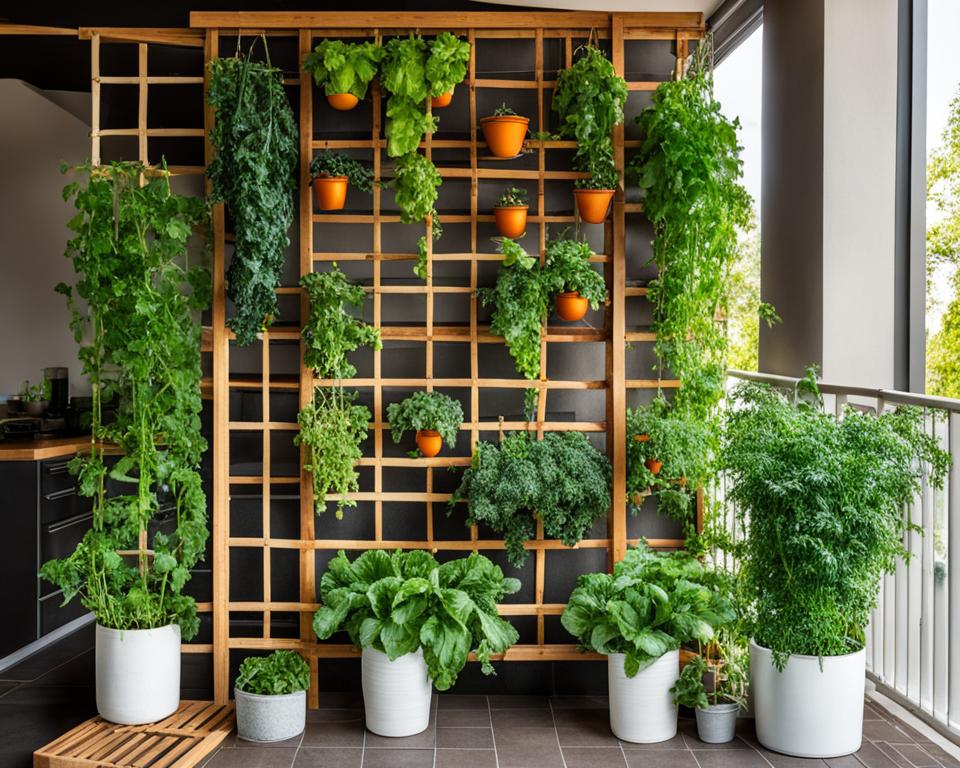Are you looking to transform your cramped patio or compact urban garden into a lush, productive oasis? Vertical gardening could be your ideal solution. Embracing the trend of vertical gardening vegetables not only maximizes your yield in minimal space, but it also adds an element of beauty to your outdoor living area. Whether you’re new to the world of gardening or a seasoned green thumb, this guide will provide you with the best vegetables for vertical gardening along with essential vertical vegetable gardening tips to ensure success. Get ready to explore a diverse palette of vertical gardening ideas for vegetables that can flourish even when space is at a premium.
Key Takeaways
- Discover vegetables perfectly suited for growing upwards, enhancing both yield and aesthetics.
- Learn vertical gardening tips that make the most of limited garden areas.
- Gain insights into the best crops adaptable for vertical growth to enrich your garden’s diversity.
- Understand how vertical gardening can transform a small space into a productive growing area.
- Explore innovative ideas for integrating vertical structures into your garden design.
- Uncover the benefits of vertical gardening for city dwellers and those with space constraints.
- Enhance your gardening know-how with techniques specific to vertical vegetable cultivation.
Why Vertical Gardening Maximizes Your Small Space
Discover how the innovative approach of vertical gardening can help you maximize small garden space and yield bountiful crops. Whether you’re an urban inhabitant with a balcony or a homeowner with limited land, employing vertical gardening ideas for vegetables is not just practical but visually impressive too.
The Advantages of Growing Upwards Not Outwards
Embracing vertical gardening benefits means you can grow an array of the best plants for vertical gardening without the need for expansive horizontal space. This method is a game-changer in urban settings, where every square inch matters, allowing growers to utilize vertical surfaces and enjoy the rewards of homegrown produce.
Vertical Gardening: Aesthetic and Practical Benefits
Not only does vertical gardening create the perfect opportunity to maximize small garden space, but it also adds an aesthetic appeal to your area. With the right setup, a vertical garden can transform a bare wall or fence into a lush and vibrant living tapestry.
From City Lots to Acreages: Adapting Gardening Techniques
Whether you’re dealing with restrictive city lots or more spacious acreages, vertical gardening scales well to fit any area. It makes garden management simpler and introduces a striking visual dimension to the landscape—turning functional spaces into gorgeous green zones.
| Vegetable | Type | Reason for Suitability |
|---|---|---|
| Tomatoes (Indeterminate Varieties) | Climbers | Adaptable to trellises and requires less ground space |
| Peas | Climbers | Natural vertical growers, ideal for small spaces |
| Pole Beans | Climbers | Thrives when trained on poles or trellises |
| Herbs (e.g., Basil, Mint) | Non-Climbers | Perfect for vertical pocket gardens or living walls |
| Strawberries | Spreaders | Great for hanging baskets, saving valuable ground space |
Essential Tips for Growing Vegetables Vertically
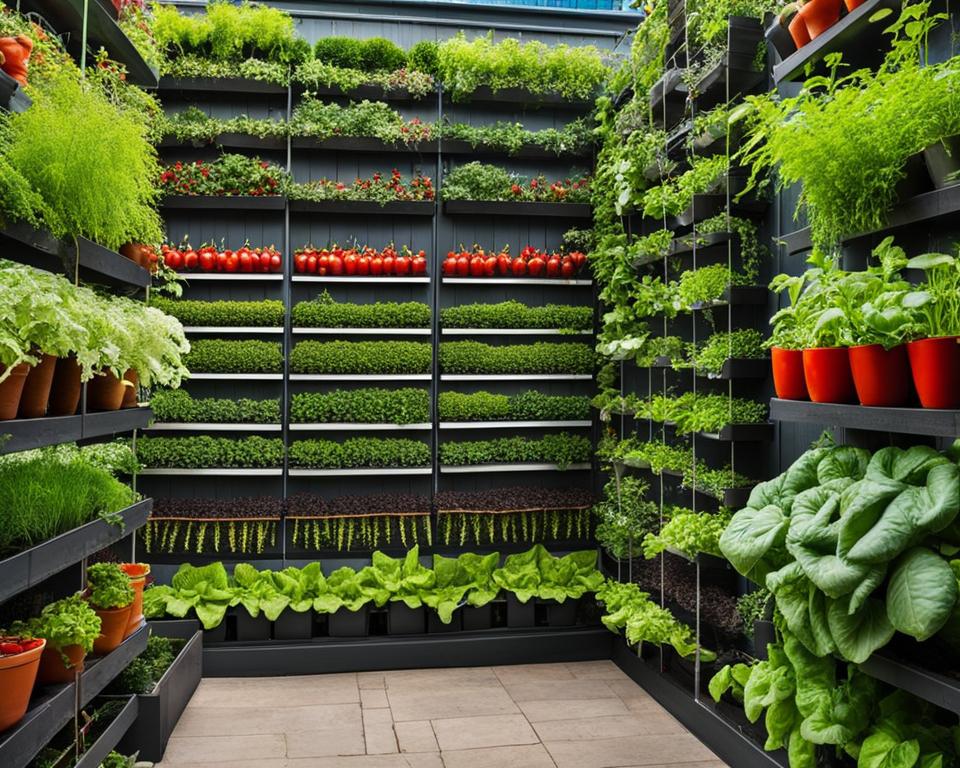
As you embark on the rewarding journey of vertical vegetable gardening, it’s important to arm yourself with valuable tips for growing vegetables vertically. The success of your garden hinges on selecting the right crops and understanding their specific needs when it comes to vertical growth. Certain vegetables will thrive with trellis support, while others might need more robust structures like tomato cages to reach their potential. Here are some pivotal vertical vegetable gardening tips that will help you cultivate a lush and productive vertical garden.
To ensure you choose the best crops for vertical gardening, consider the following points:
- Opt for vining and climbing varieties of vegetables such as beans, cucumbers, and tomatoes, which easily latch onto vertical structures.
- Remember that some plants, including zucchini and certain types of squash, can be guided to grow vertically with a little extra support and training.
- Utilize a variety of support structures, from simple stakes and netting to elaborate trellises and arches, depending on the crop’s requirements.
- Maintain appropriate spacing between your plants to ensure they receive ample light and air circulation, minimizing the risk of disease.
- Implement regular maintenance practices, such as pruning and tying, to encourage your vegetables to climb and enhance their exposure to sunlight.
Consider the following table to help decide which types of support are suitable for your vertical garden’s inhabitants:
| Vegetable | Type of Support | Additional Notes |
|---|---|---|
| Cucumbers | Trellises or A-frames | Train young plants early to climb |
| Tomatoes (Indeterminate) | Vertical stakes or caged trellis | Requires tying and regular pruning |
| Peas | Netting or chicken wire | Prefers cooler weather; minimal maintenance |
| Beans | Pole structures or teepees | Encourage natural twining around the poles |
| Zucchini | Tomato cages or sturdy trellis | Need to be secured due to the weight of the fruit |
Moreover, it’s crucial to implement preventive measures against pests and diseases that could be more prevalent in tightly spaced vertical settings. Regular inspection of your vertical plants, coupled with organic pest control practices, will help keep your garden healthy and fruitful. In essence, your careful planning and attention to the nuanced details of vertical gardening are the keystones to harvesting a bountiful and vibrant vertical garden.
The Top Vegetables for Vertical Gardening
When you’re looking to create a garden that reaches for the sky, certain vegetables stand out as the best choices for vertical gardening. In this section, we’ll explore the top vegetables that grow well vertically, ensuring you make the most of your upward space. Whether you’re working with a small balcony or a larger outdoor area, these vegetables are perfect for achieving lush, productive, and vibrant vertical gardens.
Picking the Right Pumpkins for Vertical Growth
Opt for compact pumpkin varieties such as ‘Jack Be Little’ and ‘Baby Boo’ if you want to add a touch of autumn whimsy to your vertical garden. These varieties are well-suited for vertical growth and can flourish when given the proper support in large pots or raised beds.
Squash Varieties Suited to Trellises and Containers
Container-friendly squash like ‘Small Wonder’ spaghetti squash will thrive in vertical garden setups. Utilize sturdy trellises to keep these plants elevated and productive throughout the growing season.
Indeterminate Tomatoes: Perfect for Vertical Techniques
There are few sights as rewarding as a vertical garden abundant with ripening indeterminate tomatoes. These plants love climbing up strings or trellises, inviting you to maximize your vertical space and enjoy a bountiful harvest of tomatoes.
Cucumber: A Great Candidate for A-Frame Trellises
Cucumber vines are natural climbers that excel when paired with an A-frame trellis, enabling easy harvesting and efficient use of space, while contributing to the health of the plant.
Growing Sweet and Regular Peas on a Vertical Plane
For those looking for an early-season vertical garden, sweet and regular peas are an excellent choice. These cool-season climbers can grow vertically with ease, usually requiring just a simple support system.
Bean Varieties: From Bush to Pole
From the sturdy ‘Blue Lake’ pole beans to the visually striking ‘Scarlet Runner’, beans are incredibly versatile in vertical gardens. Beans that climb can be trained up poles or trellises, while those that grow in bushes benefit from vertical space to spread out.
| Vegetable | Type | Ideal Support Structure |
|---|---|---|
| Pumpkins (small varieties) | Vining | Large pots or raised beds with sturdy supports |
| Squash (e.g., ‘Small Wonder’) | Vining | Trellises or vertical containers |
| Indeterminate Tomatoes | Vining | Strings, trellises |
| Cucumbers | Vining | A-frame trellises, strings, or pallets |
| Peas (sweet and regular) | Climbing | Netting or thin support structures |
| Beans (bush and pole varieties) | Climbing/Bush | Trellises for pole beans, supported structures for bush beans |
These top vegetables for vertical gardening can help you transform any vertical space into a lush, edible tower. Whether you’re expertly crafting a garden wall with espaliered fruit trees or stringing up cascading tomatoes, the sky’s the limit with these plants. Not only do they save space, but they also promise an attractive and productive garden area that is a joy to tend and harvest.
Integrating Vertical Gardening into Your Landscape
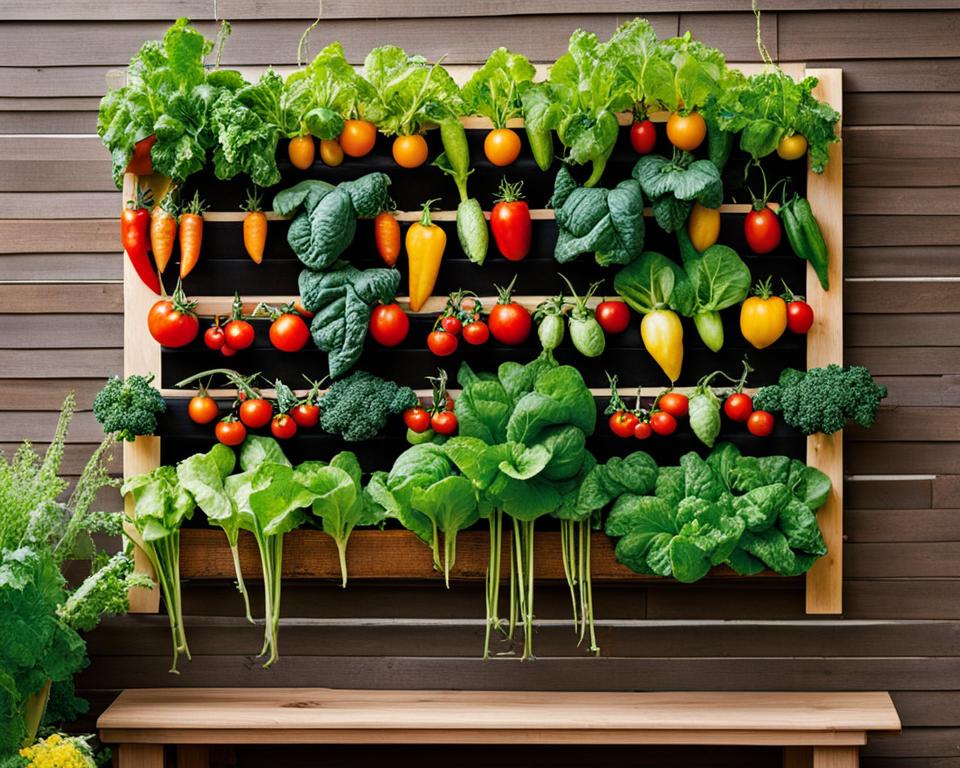
Embrace vertical gardening to maximize your cultivation space and add a decorative touch to your surroundings. Whether you’re an avid gardener or a DIY enthusiast, integrating vertical structures for vegetable growth can be both economical and striking in appearance. Let’s explore the steps you can take to develop your own vertical garden, an oasis of lush, edible greenery that thrives even in the smallest of spaces.
Choosing Economical and Aesthetic Structures
When considering the integration of vertical gardening vegetables into your landscape, the judicious selection of structures is paramount. Your choices should reflect a balance between cost-effectiveness and visual appeal. Various materials can be repurposed to create functional and artistic vertical gardening set-ups. Popular DIY options include reclaiming wooden pallets or employing sturdy chicken wire to construct frames that support the growth of the best vegetables for small space vertical gardens.
Getting Creative with Trellises: DIY Ideas
For the hands-on gardener, engaging in vertical gardening DIY projects can result in bespoke trellises that aren’t only helpful but also harmonize with your garden’s motif. Utilizing natural materials like bamboo can lend a rustic charm, while colorful rope netting may achieve a playful aesthetic. Here’s a simple guide to creating your own trellis structure, ensuring your garden is both productive and picturesque.
| Material | Tools Needed | Steps | Best Vegetables to Support |
|---|---|---|---|
| Bamboo poles | Garden twine, Saw | 1. Cut poles to desired height. 2. Form a teepee shape. 3. Secure at the top with twine. 4. Weave twine horizontally for additional support. |
Cucumbers, Peas, Pole Beans |
| Reclaimed pallet | Sandpaper, Nails | 1. Sand down rough edges for safety. 2. Secure pallet vertically to a wall or sturdy frame. 3. Fill slots with soil and seedlings. |
Lettuce, Herbs, Strawberries |
| Chicken wire | Wire cutters, Wooden frame | 1. Cut wire to frame size. 2. Staple wire onto frame. 3. Position frame in garden bed or against a wall. |
Tomatoes, Vining Flowers, Small Squashes |
| Colorful rope netting | Anchor hooks, Scissors | 1. Cut netting to size. 2. Attach hooks to support. 3. Hang netting from hooks, ensuring it’s taut. |
Peas, Climbing Roses, Sweet Potatoes |
By customizing your vertical gardening plans, you’ll enjoy the twofold benefit of cultivating an array of delicious vegetables while simultaneously enhancing the artistic elements of your outdoor living space. Start today and watch your vertical garden bring a new dimension to fresh, home-grown nourishment and beauty.
Expanding Your Vertical Gardens Beyond Vining Plants

When it comes to vertical gardening, many enthusiasts are familiar with trellising vining plants like cucumbers and tomatoes. Today, however, the realm of vertical gardening has expanded to include a wide variety of vegetables, thanks to recent innovations. Let’s explore how you can incorporate non-vining vegetables into your vertical garden and discuss the impact of tower garden technology on indoor gardening spaces.
How Non-Vining Vegetables Can Thrive Vertically
It’s not only the climbers and twiners that can benefit from the vertical space in your garden. Vertical gardening ideas for vegetables now include a multitude of non-vining species. Techniques such as using vertical pocket planters allow you to cultivate leafy greens and herbs without the need for sprawling garden beds. Techniques for growing these non-vining plants utilize upright structures, providing ample supports where needed, and are especially useful in turning small or underutilized spaces into bountiful hubs of greenery. These methods ensure that every inch of your garden is used efficiently, giving rise to lush foliage and fresh produce right at your fingertips.
The Tower Garden Revolution: An Indoor Gardening Solution
Another significant milestone in vertical gardening innovations is the introduction of the tower garden. This technology has revolutionized indoor vertical vegetable gardening, allowing year-round cultivation of produce such as strawberries, leafy greens, and even edible flowers. Modular systems like the Click & Grow Smart Garden 27 have made it possible to maintain a compact, automated garden in the comfort of your home. With features like built-in grow lights and self-watering mechanisms, the Click & Grow Wall Farm makes indoor gardening an effortless venture with a rewarding harvest.
By embracing these vertical gardening methods, you can make the most of your gardening space and enjoy a variety of fresh vegetables throughout the year. Whether you’re looking to enhance your outdoor garden or create a lush indoor oasis, these innovative solutions offer exciting possibilities for green-thumbed urban dwellers and seasoned gardeners alike.
Best Vegetables for Small Space Vertical Gardens
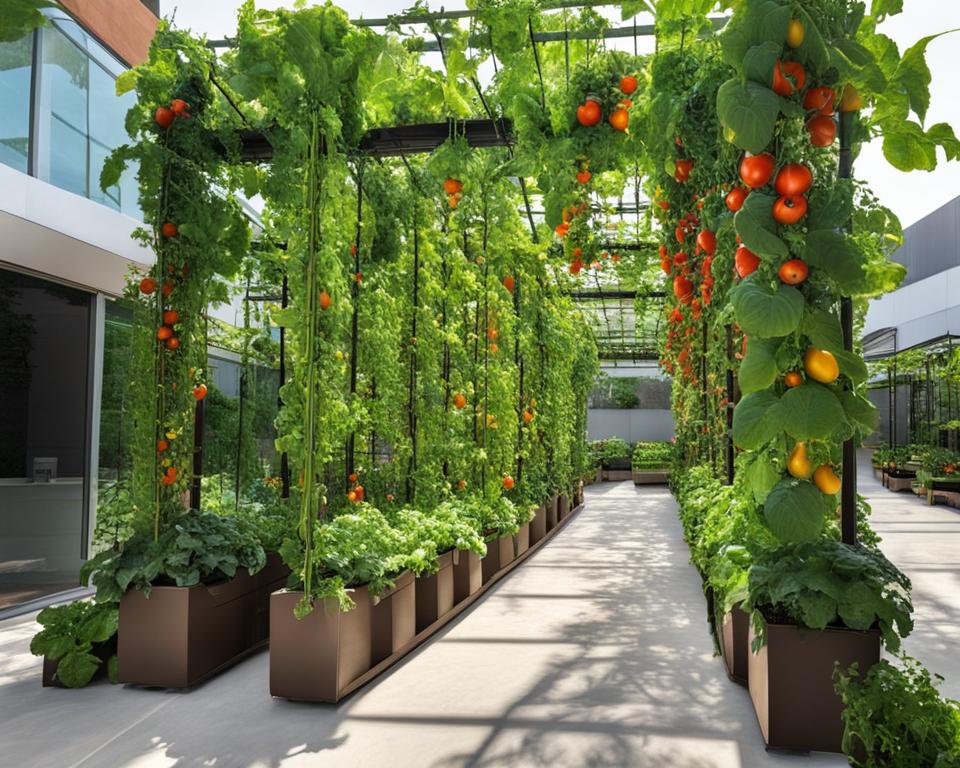
When space is at a premium, the savvy gardener turns to the innovative solutions offered by vertical gardens. Not only do they accentuate the beauty of your urban space, but they also provide practical benefits like fresh produce right at your fingertips. By selecting the best vegetables for vertical gardens, you can maximize yield in minimal space, and even use these green walls to enhance your privacy.
Maximizing Yield in Small Areas
If you’re looking to get the most out of your small garden, certain vegetables will thrive vertically and give you a greater harvest than you might expect from traditional garden layouts. Vertical gardening increases sun exposure and air circulation for plants, which can lead to a more prolific crop. Plus, it can significantly reduce the land area needed for growing, leaving more room for leisure or other plants.
Strategic Use of Vertical Gardens for Privacy and Shade
Beyond the yield of delicious vegetables, vertical gardens serve a dual purpose as a natural screen. In the close quarters of urban living, a garden that rises upwards can provide much-needed privacy from neighbors. Additionally, during the warmer months, these living walls can offer respite from the sun, creating shaded areas for you to enjoy your outdoor space.
| Vegetable | Type | Planting Notes | Vertical Support |
|---|---|---|---|
| Tomatoes (Indeterminate) | Fruit | Requires ample sunlight and spacing for airflow | Cages, trellises or stakes |
| Peas | Legume | Prefer cooler temperatures; sow in early spring | Netting or trellises |
| Beans (Pole Variety) | Legume | Plant in warm soil; avoid over-watering | Stakes or strings for climbing |
| Cucumbers | Vine | Love the sun; require consistent watering | Vertical trellis or wire framework |
| Peppers | Fruit | Can be grown in pots; need warm, well-draining soil | Small stakes or cages for support |
Gardening Ideas: Creating Beauty in Utility

When you venture into the world of vertical gardening vegetables, you’re not just cultivating edibles; you’re also enhancing the beauty of your environment. The best plants for vertical gardening are those that marry utility with splendor, transforming practical spaces into works of art.
The Artistic Appeal of Archways and High Tunnels
Imagine stepping through a lush archway brimming with ripe tomatoes or crisp beans, an inviting entry to the oasis of your own creation. Archways and high tunnels offer vertical gardening beauty that transcends the standard utility of garden beds, framing your space with green canopies and bursts of vegetables suspended like natural ornaments.
Making a Statement with Your Vegetable Garden
Vertical gardens make a vibrant statement, asserting that the best plants for vertical gardening are ones that elevate the visual appeal of your garden. They stand tall as living sculptures, contributing to the aesthetics of your outdoor living space while providing an abundant harvest. Choose climbers like delicate pea vines or robust cucumbers and watch them intertwine with elegance, a testament to both the beauty and bounty of nature’s vertical potential.
Types of Support for Your Vertical Vegetable Garden
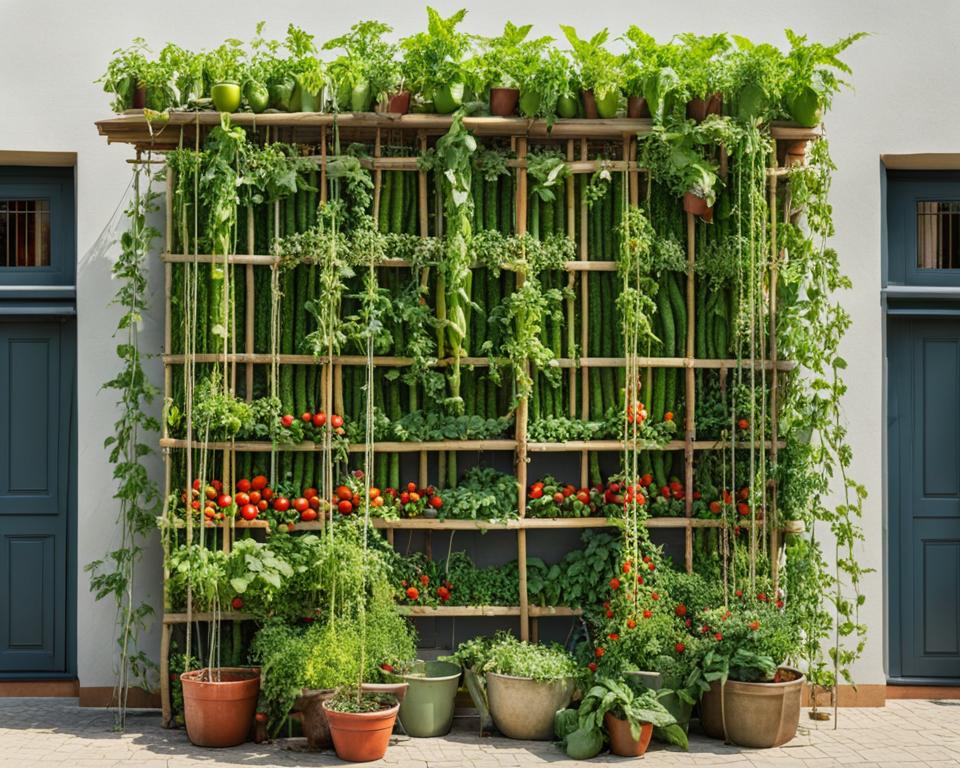
Embarking on the journey of vertical vegetable gardening necessitates the selection of suitable support systems. These structural elements are essential for both the growth of the best crops for vertical gardening and the overall sustainability and aesthetic of your garden. Let’s explore the spectrum of support options ranging from simple DIY solutions to more robust and sustainable constructions.
From Pallets to Cattle Panels: A Spectrum of Options
For those new to vertical vegetable gardening support structures, repurposed pallets present an economical and resourceful starting point. Accessible to most gardeners, pallets can be easily transformed into vertical planters for shallow-rooted crops. On the other end of the spectrum, cattle panels offer a more permanent solution, capable of supporting heavier vines and climbing plants with their sturdy grid framework.
Bamboo and Livestock Panels: Sturdy and Sustainable Choices
When considering sustainable gardening supports, bamboo stakes are an excellent choice, due to their strength, versatility, and biodegradable nature. Livestock panels are comparable in durability to cattle panels but have a more uniform grid pattern, offering robustness and ease of plant management for various vertical crops.
“Choosing the right support structure isn’t just about functionality; it’s about sustainability and longevity.” – This should be the mindset as you ponder over the vast array of options, focusing on not just the immediate needs, but the potential long-term impact on your garden’s ecosystem.
Whether you opt for a DIY approach or invest in pre-fabricated systems, the appropriate vertical vegetable gardening support can enhance both the yield and the visual appeal of your garden. With careful consideration, your vertical oasis can flourish, showcasing not only the best crops for vertical gardening, but also your commitment to sustainable and innovative gardening practices.
Boosting Plant Health with Proper Airflow in Vertical Gardens
One of the most significant vertical gardening benefits lies in its capacity to foster a healthy vertical garden environment. A key factor that often gets overlooked is the role of air circulation. Understanding how to improve airflow in vertical gardens is crucial for maintaining plant health and ensuring your garden remains a fresh, vibrant space.
The Role of Airflow in Preventing Plant Diseases
Your vertical garden’s health is directly influenced by the quality of air circulation. Poor airflow can create stagnant, humid conditions that are ideal for the spread of fungal diseases, such as powdery mildew and blight. These common ailments can devastate a garden, leading to wilted, discolored, or spotted foliage, and in severe cases, plant death. Enhancing airflow helps keep the foliage dry and reduces the risk of such infections.
Encouraging Healthy Growth and Better Harvests
Aside from preventing disease, adequate airflow has a positive impact on a plant’s structural and physiological development. By reducing the resistance to wind, plants can adapt by strengthening their stems and branches, leading to better support for fruits and vegetables as they grow. This naturally leads to bountiful, robust harvests, the ultimate goal of any garden enthusiast.
To ensure your vertical garden reaps these benefits, consider implementing strategies such as proper plant spacing and the use of trellises or supports that allow for ample air penetration. Training plants to grow in a manner that favors air movement between the leaves will also be beneficial. Remember, a breathable garden is a thriving garden.
Conclusion
As urban landscapes continue to evolve, so too does the ingenuity of urban farming practices. To embrace vertical gardening is to welcome a transformational shift towards maximizing space efficiently, all while cultivating a beautiful vertical garden that breathes life into concrete-dominated horizons. This inventive approach not only lends itself to aesthetic beauty but also fosters a more sustainable urban farming culture.
Embracing Vertical Gardening for Space Optimization and Beauty
If you live in a city apartment or a home with limited outdoor space, vertical gardening allows you to harness the vertical plane to expand your horticultural endeavors. The innovative design of vertical gardens transcends the traditional horizontal spread of cultivation, ensuring that even the most confined areas can be effectively utilized. As you cultivate upwards, your balcony, patio, or backyard becomes a lush, oxygen-rich haven, contributing to environmental health and personal well-being.
Vertical Gardening: A Step into Sustainable and Productive Urban Farming
The positive impacts of vertical gardening extend beyond its spatial benefits. In the burgeoning field of urban agriculture, this form of gardening is a testament to the possibility for high-yield crop production within small square footages. The reduced dependency on commercial agriculture and the consequent decrease in food miles underscore the vital role of vertical gardens in promoting sustainability. By adopting vertical gardening, you can enjoy fresher produce while also reducing your carbon footprint and contributing to a greener future.
Your effort to incorporate vertical techniques not only yields a bounty of vegetables and herbs but also positions you at the forefront of a vital movement. The green tapestry you create adds vibrancy to urban environments. As you water and prune, you’re not just nurturing plants—you’re pioneering a vision of urban living that brings food production back into the heart of city life, advocating for self-sufficiency and a sustainable future.
FAQs on The Best Plants for a Vertical Vegetable Garden
When embarking on the adventure of vertical vegetable gardening, a plethora of inquiries might arise, particularly regarding the **best vegetables for vertical gardening**. Understanding which plant varieties are most suitable for vertical growth and the appropriate support structures they demand is crucial. Moreover, vertical gardening introduces its own unique set of care and maintenance practices. Let’s address some of the most common **vertical gardening FAQs** that may prove invaluable as you begin your ascent into this innovative gardening approach.
Among the chief **vertical gardening queries** are questions about the right types of structures. Typically, you would aim for trellises, cages, or even modular living walls, depending on the specific plants you choose. Some plants, such as cucumbers and pole beans, thrive when twining around a simple trellis, while others, like certain varieties of squash, may need a sturdier support like a vertical cage. Watering techniques often need refinement in vertical gardens, as gravity can cause a quicker runoff, so drip irrigation or a careful hand-watering routine may be necessary. Furthermore, because vertical gardens can dry out faster, regular monitoring of soil moisture is imperative.
Another vital **vertical gardening consideration** involves the fertilization practice tailored to vertical growth. As vertical gardens may have different nutrient requirements due to their unique soil volume and exposure to the elements, it’s important to research and implement a fertilization schedule that meets the needs of your elevated plants. By being well-informed and vigilant in maintaining your garden, you can harness the advantages of vertical gardening and cultivate a thriving, productive green space in even the most confined areas.
FAQ
What are the best vegetables for vertical gardening?
Some of the best vegetables for vertical gardening include vining plants like cucumbers, indeterminate tomatoes, peas, and pole beans, as well as smaller varieties of pumpkins and squash. Non-vining plants such as leafy greens and strawberries can also be grown vertically using tower gardens or similar systems.
Can you give tips for growing vegetables vertically?
Absolutely! Begin by selecting suitable supports like trellises, nets, or cages for your vegetables. Ensure you use sturdy materials that can handle the weight of your crops. Train your plants early by gently guiding them onto the supports, and regularly prune to encourage upward growth. Additionally, make sure to provide ample water and nutrients, since vertical gardens may dry out faster than traditional gardens.
How does vertical gardening maximize small garden space?
Vertical gardening maximizes small garden spaces by utilizing the vertical plane, which allows you to grow more plants in a limited footprint. This method makes efficient use of space by encouraging plants to grow up instead of out, making it perfect for urban gardens, balconies, and patios.
What considerations should be taken when integrating vertical gardening into a landscape?
Consider the visual aspect of your garden, aiming to complement your landscape’s aesthetic. Think about the types of structures that will look best and serve the practical purpose of supporting your vegetables. Remember to factor in the sunlight requirements for different plants when positioning your vertical gardens.
Are there any particular vertical gardening innovations for non-vining vegetables?
Yes, innovations such as tower gardens have revolutionized the way non-vining plants are grown vertically. These systems allow for an array of non-vining plants like lettuces, herbs, and strawberries to be grown in vertical columns, often with hydroponic or aeroponic systems. This technology can even be adapted for indoor gardening.
How can vertical gardens be used for strategic purposes?
Vertical gardens can be strategically placed to create privacy screens, windbreaks, or shading areas. They can also be used to cover unsightly walls, reduce noise pollution, and improve the thermal regulation of buildings, thereby serving functional as well as decorative purposes.
Can vertical gardening add artistic elements to my yard?
Definitely! Vertical gardening can add immense artistic value to your yard. Use structures like archways, trellises, and high tunnels not only for plant support but also as sculptural elements. These can help define spaces, create charming pathways, and serve as appealing focal points in your garden.
What types of support structures work best for vertical vegetable gardening?
Your choice of support will depend on the types of vegetables you’re growing. Trellises, netting, and wire cages work well for climbing vegetables. More sturdy options, like cattle panels, bamboo, and metallic arbors, may be necessary for heavier crops. Be creative with pallets and DIY structures for an economical approach.
How does vertical gardening benefit plant health?
Vertical gardening can significantly improve plant health by increasing airflow around the foliage, which reduces the risk of pests and diseases. It also can create a cleaner and less hospitable environment for pests since the plants aren’t as accessible from the ground.
What challenges might I face with vertical gardening compared to traditional gardening techniques?
Some challenges include ensuring plants have sufficient support as they grow and maintaining consistent watering and nutrient supply, as vertical gardens may dry out more quickly. Learning how to train and prune your plants for vertical growth might also require some practice and research.

